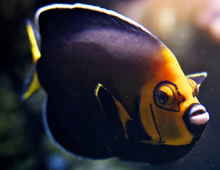Description: As adults, Spectacled or Conspicuous angelfish are blue-gray with a gold sheen. The face and bases of the caudal and pectoral fins are bright yellow. The lips are white to light blue; snout, outer half of caudal and pectoral fins are black. Gill covers and eyes have distinctive blue rims. The common name comes from the spectacle-like rings around their eyes. Juveniles are black with a greenish-white dorsal fin. Angelfish have a spine on the gill covers, as indicated by their family name, Pomacanthidae. Pom means “cover” and acanthus means “spine” in Latin.
Size: This fish grows to about ten inches (25 cm) in length.
Behavior: This species can become aggressive toward other fish. Males defend their territory from competing males in order to find a mate. Like other angelfish, caves and crevices are used for shelter.
Diet: Spectacled angelfish feed mainly on sponges, macro algae and zooplankton.
Reproduction: Spectacled angelfish are pelagic spawners; releasing many tiny buoyant eggs into the water where they become part of the plankton. The eggs float with the currents until hatching.
Habitat/range: Adults are found on coral and rocky reefs down to about 130 feet (40 m) and juveniles are found living in shallower water in protected bays. Their range includes the area from
the southern Great Barrier Reef to central New South Wales and from New Caledonia, Norfolk to Lord Howe Island.
Status: Listed as Least Concern on the IUCN Red List. Despite its territorial nature and often aggressive behavior, because of its beauty, it is a prized, sought- after fish among marine aquarium trade.



